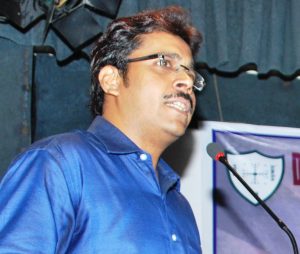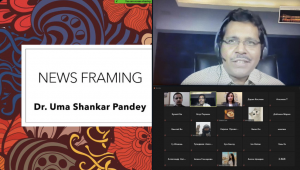
Dr. Uma Shankar Pandey, an associate professor at Surendranath College for Women.
Dr. Uma Shankar Pandey is an Associate Professor teaching media literacy at Surendranath College for Women. His research explores topics such as the evaluation of new media literacy, journalistic identity, and media credibility. Lately he has explored the intersections of digital technology and media communication, including a fascinating study on search engine promotion of electronic resources over print resources.
After some time teaching media literacy, Dr. Pandey joined our news literacy training at the Vietnam National University, Ho Chi Minh City in 2018. He was kind enough to share some of the details of his work in the 7 Q&As below, including how he is teaching via video lecture and live discussions during the pandemic. Thank you, Dr. Pandey!
Q: Would you share with us where you are teaching news and / or media literacy at the moment and tell us about the learners you work with?
A: I am teaching Bachelors students at Surendranath College for Women and also Masters students at the University of Calcutta where I am a guest faculty. Classes are generally about Media Literacy, but I have found it convenient to incorporate Stony Brook’s ‘VIA’ paradigm. It is very useful.
Q: What kinds of information challenges does society face in India? Can you talk a little bit about the news and information environment there as it is relevant to your teaching?
A: Different parts of India have unique challenges; ours is a country with 23 languages recognized as ‘official’ by the 8th schedule of the constitution. One out of every four Indian is illiterate according to the last census. Problems of access and inequity is also pervasive.
At the same time there are 850 television channels available in different languages for the 197 million television households in the country.
There is an abundance of challenges on the news and information front — unreliable content, absolute dependence on advertisement revenue and a lack of job security among media persons. Thousand of media workers have lost their jobs in the last year, ostensibly due to financial hardships caused by the Pandemic.
Q: How has the pandemic impacted your students and teaching? If you are teaching online, can you
A: The Pandemic has impacted my teaching in a huge way. I have learnt newer ways of engaging with students. In my view online classes work well with a combination of synchronous classes and asynchronous activities. I ended up starting my own YouTube channel in order to deliver lessons students can access any time. In the last three months I have uploaded 25 videos to the channel, amounting to over 16 hours of content. As a result, I find it much easier to engage students in group discussions after having shared video content with them. Online lectures may not be as effective as having discussions on pre-selected topics.

Dr. Pandey teaching.
Q: What do your learners seem to appreciate most about what they learn about news / media and information? What do they seem to challenge or have difficulty with?
A: Students seem to appreciate the sophisticated persuasive techniques that are behind the media messages. The political-economic explanation for media content and structures is also well taken by the students. A greater challenge for them is to understand why stricter regulatory frameworks are not in place and also why certain kinds of content are allowed on Twitter, for example.
Q: What is your favorite lesson or activity to teach when it comes to news and / or media literacy?
A: My favorite activity is using various clips from Bollywood to explain concepts of communication and media. This is one technique students seem to enjoy most. I regularly scout for 4–5-minute clips of content from popular Indian films to use in discussions on persuasive aspects of communication, for example.
Q: How long have you been teaching news / media literacy education and how did you become interested in it?
A: I have been teaching for more than 18 years now. Initially I taught media literacy and later took to news literacy following my training with Stony Brook. Before taking up academics was a journalist. Back then I always believed it would be important to teach media literacy once I gave up full-time journalism.
Q: Where can we learn more about the work you are doing?